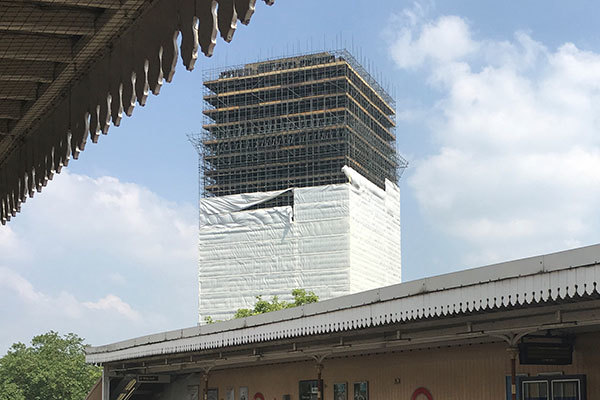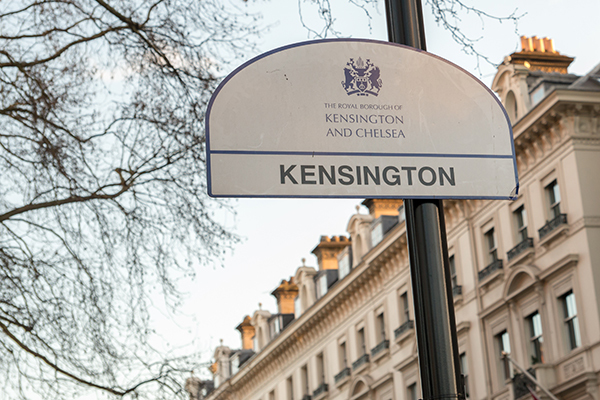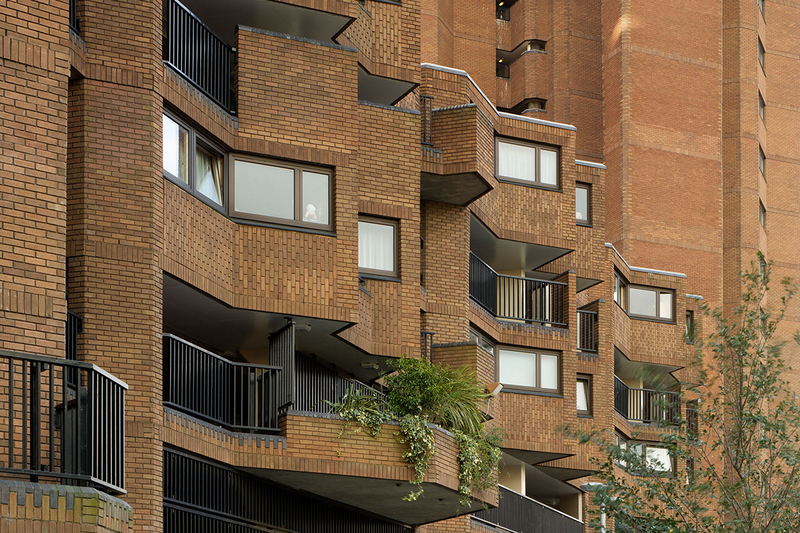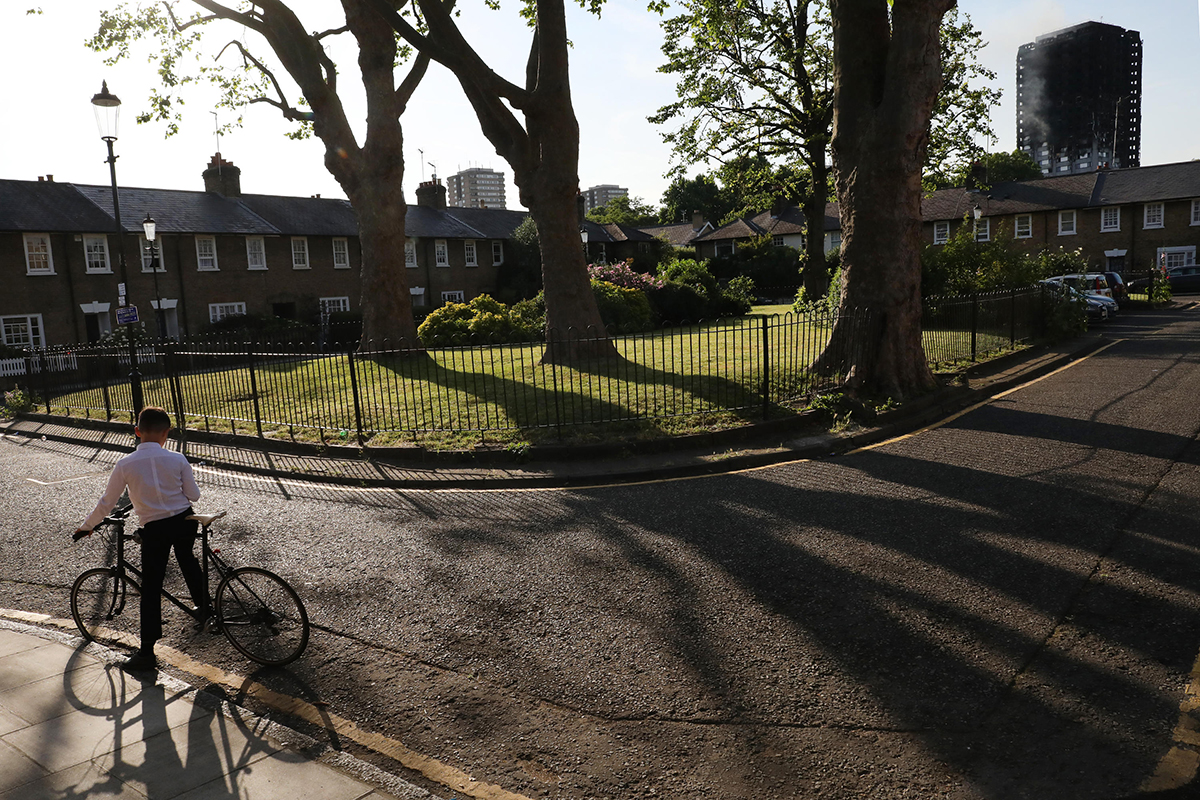You are viewing 1 of your 1 free articles
Once upon a time in the west: the history of KCTMO
The Grenfell fire appears to herald the end of an experiment in tenant-managed housing in Kensington and Chelsea. Pete Apps looks back at a sometimes difficult 20 years
It is a mark of how far we have travelled since June that it was the prime minister herself who announced Kensington and Chelsea Tenant Management Organisation (KCTMO) would no longer manage the Lancaster West Estate.
Theresa May, who had been booed off the estate when she last visited the site of the Grenfell Tower fire, announced on 23 August that she was “pleased that I was able to tell residents” that the company would no longer manage it going forward.
A day later, Elizabeth Campbell, the recently installed leader of the Royal Borough of Kensington and Chelsea (RBKC) went further. “Public trust has been broken,” she said. “There is no future role for the KCTMO.”
There are those in the social housing sector who feel a degree of sympathy for the now infamous organisation. While the cladding installed on Grenfell Tower was clearly – and catastrophically – far from safe, the scores of other landlords currently scrambling to remove similar insulation products from buildings shows that KCTMO was not alone in making this mistake.
“I’m feeling quite sore for them actually,” says one sector source, following the prime minister’s comments. “It could have been any one of a hundred bodies. They followed the rules, used reputable people. The system failed them. But they are at the bottom of the food chain and they are a popular target, which is why the PM feels she can throw them under the bus.”
KCTMO is and always has been a unique outfit – a curiosity in the social housing sector. Tenant management organisations are commonplace but are usually set up to cover a single estate, or even just a single block.
KCTMO, however, ruled over an empire. It is still responsible for 9,000 homes stretching across some of the most prosperous, deprived and iconic parts of west London – from the World’s End Estate on the banks of the Thames to Notting Hill, Portobello Road and Erno Goldfinger’s Trellick Tower.
On paper, at least, KCTMO is empowering – tenants hold the majority vote on its board and it was set up to hand power over to residents. But its history, particularly the relationship with some of these tenants, was at times a troubled one – long before flames took hold on the fourth floor of Grenfell Tower. As the organisation’s final chapter looms, Inside Housing takes a look back at some of its difficulties.
Avoiding transfer
When KCTMO launched in 1996, it was considered pioneering. “It was seen as quite radical for a true blue Tory council to be setting up a tenant management body,” one housing figure recalls.
The rationale for this move was economics and politics.
In 1994 the waning Conservative government was pushing a new policy: Compulsory Competitive Tendering (CCT). It intended that all councils contract out management of their housing stock by 1999. In many cases this led to stock transfer, but this was a result Kensington and Chelsea Council was desperate to avoid. The council feared a stock transfer would eventually spell the end for social housing in the borough.
There was one loophole in the regulations. A 1994 Parliamentary briefing into CCT notes tenant management organisations would be exempt. This had in mind the small estate-wide organisations characteristic of most TMOs. A borough-wide TMO was a bold and unique way round this. It was also a flagrant subversion of the Conservative government’s policy aim.
“It was a wheeze the council came up [with] because it was very worried about losing social housing in the borough,” says one lawyer, familiar with the operation of KCTMO. “Because of where they are, these properties are just incredibly valuable assets. If it had transferred its stock, there wouldn’t be anything to stop a housing association selling the homes as they become vacant and using the receipt to build four homes elsewhere.”
Indeed, this practice is not uncommon among large London housing associations – and may yet be the fate of the council homes in Kensington and Chelsea if the council goes ahead with its promise to scrap KCTMO.
Another housing figure, involved in council housing at the time, recalls resentment in the sector that flagship Tory borough Kensington and Chelsea was able to evade the tendering process others were forced to go through.
“It was seen as radical for a Tory council to be setting up a tenant management body.”
According to historic council papers, held in the dusty archives of Kensington Library, a ballot of tenants took place in February 1994 with all tenants and leaseholders asked to vote on a deceptively simple question: “Are you in favour of increasing tenant and leaseholder control of council housing in Kensington and Chelsea by developing a tenant management organisation?”
Perhaps unsurprisingly – given its wording – the response to the ballot was conclusive. In total 5,663 residents voted yes, accounting for 93% of all votes cast.
Divided responsibility
It took a further two years for the organisation to get off the ground, but it finally launched on 1 April 1996, operating under a management agreement drawn up by the council with 20 board members – 13 of whom were tenants, voted in via an electoral college of residents.
Under the original management agreement, also available in historic council papers, monitoring the performance of KCTMO fell to the council. Notably, given what happened two decades later, the agreement states that there should be “divided responsibility” for contracts on works worth more than £400,000, which the council must be allowed to approve. This means that, in the event of problems with major works, both the council and KCTMO would be liable – a clause which may well raise its head as the fallout from Grenfell develops.
The agreement also notes that the Lancaster West Estate was already managed by residents through an estate management board set up years earlier. The agreement promises to “maintain the independence” of this smaller body – more on which later.
This was how KCTMO was created and how it took over management of the council’s housing stock. But six years later, in 2002, its legal status changed.
It became an arm’s-length management organisation – a mechanism commonly used by councils to manage their stock – which was a move necessary to allow it to access New Labour’s Decent Homes funding. The number of tenants on its board was also reduced, although they remained a majority.
During this time KCTMO had some success. In 2006 it was given an ‘excellent’ three star rating with excellent prospects for improvement by the Audit Commission – the body responsible for inspecting local public bodies. But relations with many tenants were strained.
Chances to improve
Matters came to a head in 2008. In March, KCTMO held an extraordinary general meeting – partly in response to longstanding concerns over repairs. Following this, Fiona Buxton, then-cabinet member for housing at RBKC, said the council would “clear the air” by appointing an independent adjudicator to investigate complaints.
“The TMO has been subject to a drip-drip of allegations and complaints which has dented the confidence of some tenants and leaseholders and lowered staff morale,” she said.
After spending months reviewing documents and emails and speaking to tenants, adjudicator Maria Memoli’s report was published in April 2009. It reveals an organisation with serious problems.
“There was a general feeling among residents (leaseholders and tenants alike) that the quality of cyclical repairs and major works were sub-standard,” wrote Ms Memoli at the time.
“The council was very worried about losing social housing in the borough.”
She gives a number of examples, which include contractors breaking down a door to the wrong flat to make a repair, a tenant waiting for 20 years for a leak to be fixed before she was decanted due to the damage it caused, and central heating systems being fitted so badly the resulting noise damaged residents’ health. “The TMO has ruined my life,” one resident told the adjudicator.
Ms Memoli made a number of recommendations for tighter oversight of KCTMO by the council. This included – poignantly, in the light of what we already know about the Grenfell refurbishment – a requirement that the council “take more of a proactive role in the monitoring of major works contracts” and KCTMO “take a more robust monitoring role of major works contracts”.
But this was not to be taken on board. In its April 2009 response, KCTMO said: “The council believes the TMO overall has in place effective contract management… [and] the TMO is satisfied current arrangements are compliant with best practice.”
Never Again campaign
Inside Housing has launched a campaign to improve fire safety following the Grenfell Tower fire
Never Again: campaign asks
Inside Housing is calling for immediate action to implement the learning from the Lakanal House fire, and a commitment to act – without delay – on learning from the Grenfell Tower tragedy as it becomes available.
LANDLORDS
- Take immediate action to check cladding and external panels on tower blocks and take prompt, appropriate action to remedy any problems
- Update risk assessments using an appropriate, qualified expert.
- Commit to renewing assessments annually and after major repair or cladding work is carried out
- Review and update evacuation policies and ‘stay put’ advice in light of risk assessments, and communicate clearly to residents
GOVERNMENT
- Provide urgent advice on the installation and upkeep of external insulation
- Update and clarify building regulations immediately – with a commitment to update if additional learning emerges at a later date from the Grenfell inquiry
- Fund the retrofitting of sprinkler systems in all tower blocks across the UK (except where there are specific structural reasons not to do so)
We will submit evidence from our research to the Grenfell public inquiry.
The inquiry should look at why opportunities to implement learning that could have prevented the fire were missed, in order to ensure similar opportunities are acted on in the future.
Picture: Alamy
The aftermath of the Grenfell Tower fire seen from a distance
More broadly, Ms Memoli found issue with the culture at KCTMO, with residents frustrated that they sometimes had to wait years for a response to complaints. “Words such as ‘malevolent’, ‘mistrust’, ‘malaise’ and ‘treated with contempt’ were often used,” she wrote. She said she found some evidence of this behaviour on inspection, concluding: “This is an unhappy culture and needs to change for the better.”
She also made note of some worrying governance issues. “There were some complaints that some board members abuse their positions so as to be given priority treatment,” she wrote. “Evidence found this to be true in some instances.”
A few months after the report was published, the new chief executive Robert Black gave an interview to the local press in which he vowed to “wipe the slate clean” at the organisation, which was described as “racked by infighting and rebellion”. He promised a focus on improving repairs, to create cohesion on the board and change residents’ perception of the organisation for the better. “We need to rebuild that trust with people who are angry with us,” he said.
Disastrous consequences
A spokesperson for KCTMO says it improved its operations “dramatically” after 2009. The spokesperson added that in the last poll of residents, in September 2013, 75% said they were happy with the service – up from 56% in 2008, and 86% said they wanted it to continue managing their homes, its best ever score.
Picture: Alamy
The iconic Trellick Tower
However, in Lancaster West the relationship remained strained. Despite the 1996 promise to protect its independence, the estate management board was wrapped up by KCTMO in 2013. Around this time, major construction work near the estate and power surges affecting 45 flats in Grenfell Tower led to a growing sense of anger among residents.
It was in this context that the refurbishment of Grenfell Tower began in 2015. In 2016, residents brought a now well-known series of substantial complaints about the work to the council. To investigate these complaints KCTMO appointed itself, and produced a report which praised its contractor and even itself for its “high quality management of the project over 22 months”.
“This is an unhappy culture and needs to change for the better.”
Residents felt ignored. Labour ward councillor Judith Blakeman told the council in March 2016: “We are aware of a groundswell of concerns about [KCTMO] throughout the borough. We must therefore ask [KCTMO] to consider seriously whether producing [this] report… assists [its] reputation – or its chances of rebuilding a relationship with the residents of Grenfell Tower.”
This warning went unheeded. As did that from the Grenfell Action Group blog, which said in November 2016 that “only a catastrophic event” would force the council to listen. Residents’ calls for the appointment of an independent adjudicator like Ms Memoli to investigate fire risk were rejected just five weeks before the blaze.
What happened next is well known, costing the lives of at least 80 tenants and drawing the history of KCTMO towards a tragic conclusion.
And so what began as an organisation promising to give poor tenants in the richest part of London a louder voice looks set to end facing questions at a public inquiry about whether its failure to listen contributed to the deaths of 80 of them.
The KCTMO response:
“As a resident-led organisation we want answers to what happened during the tragic events at Grenfell as much as anyone else and that’s why we will continue to do all we can to co-operate with and help all the investigative processes as much as we can.
“Since 2009 the TMO has improved its operations dramatically following the arrival of Robert Black that year as the new CEO, a new board, a new executive team and a new relationship with the council.
“We’re required every five years to carry out, as part of the modular management agreement which we have with the council, a test of opinion poll. Overwhelming endorsement of the dramatic improvement in our operations was provided in the last wide-ranging poll of residents in September 2013, which was managed and supervised on our behalf by UK Engage.
“In this poll we received a resounding endorsement, when 86% of residents who voted said that they wanted us to carry on managing their homes on behalf of the council. There was a record participation in the vote, with 3,420 residents taking part (122% higher than in the previous poll). Residents were also asked about their overall satisfaction with the service we provide. 75% said they were happy with the service; this contrasts with only 56% in the 2008 Status survey. It was our highest ever score.”
Update: at 15.30am, 07.09.17: This article was updated with additional detail about Compulsory Competitive Tendering (CCT)

















